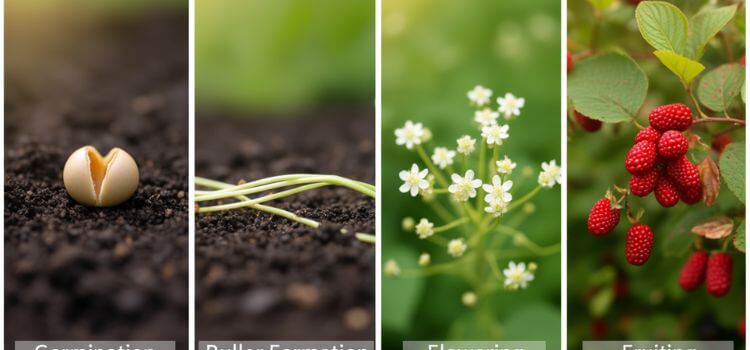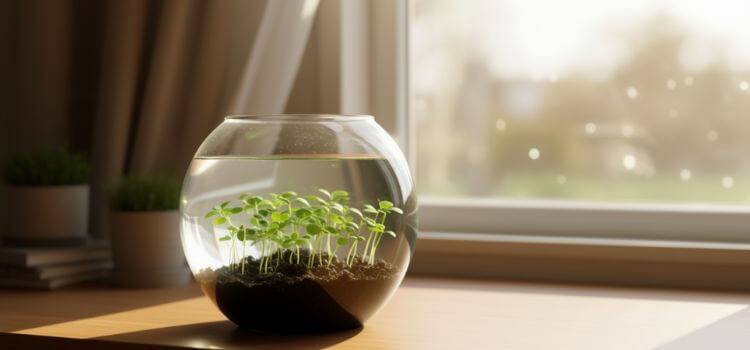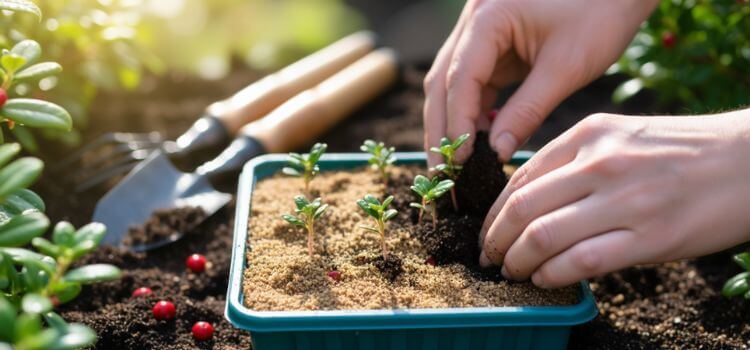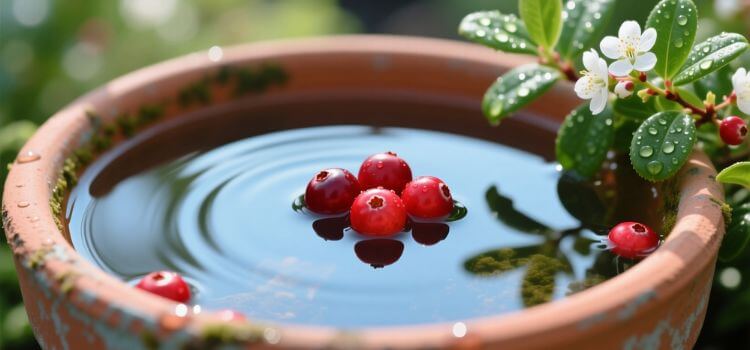As an Amazon Associate, I earn from qualifying purchases.
Have you ever looked at those bright red cranberries floating on water and wondered, “Can I grow them at home like that?”
When I first saw it, I thought it was just for decoration. But then I learned something surprising — cranberries actually grow best in moist, water-loving conditions!
Growing cranberries in water sounds unusual, right? Most of us think plants need dry soil and sunlight. But cranberries are different. They belong to the Vaccinium family, like blueberries, and thrive in cool, wet environments.
Now, you might think it’s not very easy, but let me tell you — it’s easier than it looks!
I started mine in a small plastic tub with a few simple materials, and within weeks, tiny green shoots appeared. Seeing that transformation felt magical — like watching tiny ruby gems forming in a pool of nature’s beauty.
In this guide, I’ll show you step by step how to grow cranberries in water — even if you’ve never planted anything before. You’ll learn what makes them thrive, how to care for them, and how to enjoy your own mini cranberry marsh at home.
So, grab a cup of tea, take a deep breath, and imagine those glossy red berries floating gently in water — let’s grow them together!

What Makes Cranberries So Unique?
Before we dive into how to grow them, let’s talk about why cranberries are so special.
Cranberries are one of the few fruits that naturally thrive in acidic, bog-like soil. They don’t grow in deep water, but they do grow near it — in wetlands where the soil is moist, spongy, and rich in organic matter.
That’s why farmers often flood cranberry fields during harvest season — the berries float, making them easy to collect. It’s a fun sight to see thousands of red berries bobbing on the surface like a red ocean!
Here’s a simple comparison to understand the growing method:
| Feature | Typical Garden Plants | Cranberries |
|---|---|---|
| Soil Type | Dry, neutral soil | Moist, acidic peat |
| Water Need | Moderate | Constant moisture |
| Harvest Method | Hand-pick from soil | Float on water |
| pH Level | 6.0–7.0 | 4.0–5.0 (acidic) |
Cranberries are a symbol of patience and care — like a slow-cooked meal that rewards you with flavor. They teach you that growth takes time but is worth every moment.
Step-by-Step: How to Grow Cranberries in Water
I’ll walk you through the entire process in simple, clear steps — no fancy tools needed!
1. Choose the Right Container
You don’t need a big pond! Start with:
- A wide plastic tub or basin
- Depth: 8–10 inches
- Small drainage holes (yes, they need a little drainage too)
I used a shallow rectangular tub, and it worked beautifully.
2. Prepare the Growing Medium
Cranberries love acidic, peaty soil. Mix:
- 2 parts peat moss
- 1 part sand
- 1 part garden soil
Fill your container halfway with this mixture. It should feel slightly wet but not soggy.
Pro tip: Add a few small stones at the bottom to improve air circulation.
3. Add Water Gently
Pour clean water until the top layer is just moist — not flooded.
The goal is to keep the soil wet —like a sponge —not to turn it into a swimming pool.
Later, when the plants mature, you’ll occasionally flood the container (we’ll talk about that soon).

4. Plant the Cranberry Cuttings or Seeds
If you’re using seeds:
- Soak them overnight in water.
- Plant ¼ inch deep in the soil mix.
- Keep the container in a bright, cool place.
If using cuttings (my favorite method):
- Take 4–6 inch long cuttings from a healthy cranberry plant.
- Remove the lower leaves.
- Insert them gently into the soil.
Within 2–3 weeks, they’ll start rooting and sending out runners. Watching those little green lines stretch out feels like seeing nature paint its own picture!
5. Maintain Water Levels
Cranberries like wet feet but dry heads — meaning the roots should stay moist, but the upper stems should not drown.
Here’s a simple routine:
- Keep water level 1 inch below the soil surface during growth.
- Flood the container for 1–2 days once a month to simulate natural bog conditions.
It’s like giving your plants a spa day — they love it!
6. Sunlight & Temperature
Cranberries love cool weather and gentle sunlight.
Place your container in a spot that gets 4–6 hours of direct sunlight.
If it’s too hot, give them some shade during the midday hours.
7. Patience Pays Off
Cranberries grow slowly at first. Don’t lose hope!
In the first year, they’ll focus on spreading runners (horizontal stems).
Fruits usually appear in the second or third year.
When those red berries finally show up, it’s like your plant whispering, “Thank you for believing in me.”
How to Care for Cranberries in Water
Caring for cranberries is not hard — but it needs consistency.
Here’s what I’ve learned from my own trial and error:
Watering Tips
- Always keep the soil moist, not muddy.
- During dry seasons, mist the plants daily.
- Use filtered or rainwater — tap water may raise the pH level.
Fertilizing
Use a light, organic fertilizer twice a year.
Avoid chemical ones — cranberries are sensitive.
Pruning
After every growing season, trim extra runners.
This keeps your plants healthy and compact.
Pest Control
Common pests: aphids, fruit worms, and mites.
Use neem oil spray or a mild soap solution weekly.
Important Note: Never overuse pesticides on water-grown plants — it harms both the plant and water quality.

Can You Grow Cranberries Indoors in Water?
Yes, you absolutely can! I’ve done it using a small glass aquarium.
Here’s what I did:
- Lined the bottom with small pebbles.
- Added the peat-sand-soil mix.
- Kept the top open for sunlight.
It became a beautiful mini cranberry bog — perfect for small spaces.
Even visitors were surprised to see berries growing inside water!
Tip: Place your setup near a bright window or under a grow light.
Common Mistakes to Avoid
Even the best gardeners make mistakes. Here’s what I learned the hard way:
- Too much water: Flooding daily will drown the roots.
- Wrong soil pH: Keep it acidic (around 4.5–5.0).
- Not enough sunlight: Makes the plants weak and pale.
- Overfertilizing: Causes leaf burn and poor fruiting.
- Ignoring pests: Early prevention saves your harvest.
Note: Cranberries are like children — too much care can sometimes spoil them.
Cranberry Growth Timeline
| Growth Stage | Duration | Key Task |
|---|---|---|
| Seed Germination | 2–3 weeks | Keep soil moist |
| Runner Formation | 1–2 months | Support spread |
| Flowering | 1 year | Maintain sunlight |
| Fruiting | 2–3 years | Reduce water slightly |
| Harvest | Late autumn | Flood lightly to collect berries |
This table shows that growing cranberries isn’t a weekend project — it’s a journey. But trust me, every step feels rewarding.
FAQs: How to Grow Cranberries in Water
1. Do cranberries actually grow in water?
Not precisely in water — they grow in moist, peaty soil near water. Farmers flood the fields only during harvest to float the berries.
2. Can I grow cranberries at home without a pond?
Yes! You can grow them in tubs, containers, or aquariums as long as you keep the soil moist and acidic.
3. How long does it take to get cranberries from seeds?
Usually 2–3 years. They grow slowly but produce fruit for decades once mature.
4. What’s the ideal pH level for cranberry soil?
Between 4.0 and 5.0 — very acidic. You can add peat moss or pine needles to maintain acidity naturally.
5. Can cranberries survive hot weather?
They prefer cool conditions. In hot areas, give them partial shade and mist regularly.
Conclusion
Growing cranberries in water isn’t just gardening — it’s like creating your own little wetland full of life and color.
At first, it might feel strange — soil that’s always wet, slow growth, no fruits for months. But when those first red berries appear, you’ll realize the wait was worth it.
It’s similar to life — you don’t see results immediately, but with patience and care, beauty always blooms.
Cranberries teach us that even in the toughest, rockiest conditions, life can flourish if given the right balance of water, light, and love.
So, are you ready to start your cranberry-growing journey?
Grab a tub, some peat, and a little hope — your own cranberry garden is waiting to be born.

